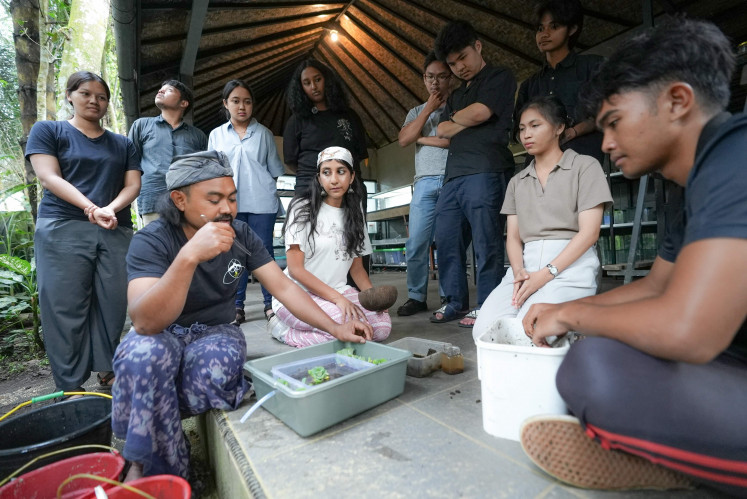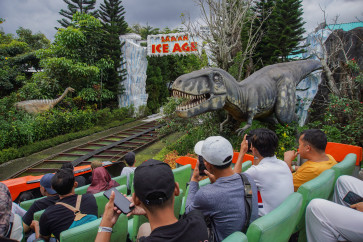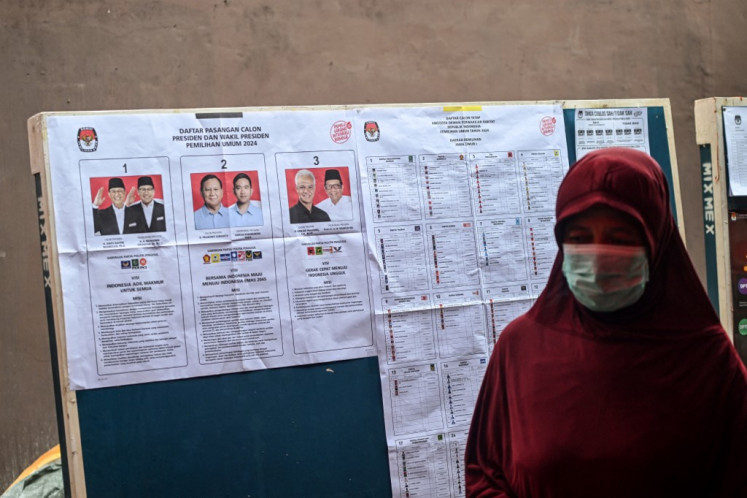Popular Reads
Top Results
Can't find what you're looking for?
View all search resultsPopular Reads
Top Results
Can't find what you're looking for?
View all search resultsIn Timika, finding a fortune in crocodile skin
Reasonable: The prices for crocodile leather products in Timika are reasonable, ranging from Rp 250,000 for a belt, a pair of shoes for Rp 1
Change text size
Gift Premium Articles
to Anyone
R
span class="caption">Reasonable: The prices for crocodile leather products in Timika are reasonable, ranging from Rp 250,000 for a belt, a pair of shoes for Rp 1.8 million or a handbag for Rp 2 million.
In Timika, tanners and leather workers have banded together in collectives to work with the skins of crocodiles.
Representatives of the collectives, which have permits from the local Forestry Agency and Natural Resources Conservation Agency, say business has been brisk, with profits topping Rp 300 million (US$26,362) a month.
One of the tanners, Pardianto, owns the Argo Boyo workshop. He describes himself as the pioneer in the local crocodile tanning business.
The 45-year-old came from Karanganyar, Central Java, to Papua in 1991 to find his fortune. While he started out selling leather shoes, belts and purses; after eight years he became a leather worker.
'In 1999, I started running crocodile leather handicrafts by employing six locals around my workshop, Pardianto said. 'I watched and learned from those who were skilled how to skin crocodile leather.'
He continues. 'It took me long enough to be skilled when I was in Jayapura. Instead of simply reselling the crocodile leather, I thought I'd better become a craftsman.'
At work: The tanners say that demand has outstripped supply ' quite a change from the situation two years ago, when they could only sell about 60 percent of their monthly output.
Pardianto says that he's never at a want for raw material: Crocodiles abound in the rural areas of Timika and members of the Kamoro tribe visit him almost every day with fresh skins.
Another tanner, Unggul, 40, runs the four-person Joyoboyo workshop on Jl. Serui. He said that a single crocodile carcass had a host of uses. 'A crocodile has a lot of functions, namely its leather to be tanned, teeth as necklace beads, gall for medication and eggs and meat for food.'
Pardianto says that the skin is most valuable to him. 'An inch of crocodile leather costs Rp 40,000. A single piece of crocodile leather can reach up to 20 inches. Once every three days I can get a piece of raw leather that's as big as 200 inches.'
The workshops make about 500 purses, 25 handbags, and 150 belts a month that are then typically resold in Merauke, Sorong or Timika.
The tanners say that demand has outstripped supply ' quite a change from the situation two years ago, when they could only sell about 60 percent of their monthly output.
Now there are buyers from outside Timika, from big cities such as Jakarta. Many have placed huge orders.
'We receive orders from clients every week,' added Tomy, the owner of Arto Boyo. The 42-year-old came from Cilacap, Central Java, looking for work five years ago.
Another tanner, Usman Sugianto, said that the collectives have rejected loans offered by banks to buy equipment to mechanize the process.
'Big capital is necessarily required if we want to buy modern tanning machines,' Sugianto said. 'But we can't afford the maintenance, not to mention other costs. In addition, it needs funds for permits from the government to operate.'
Pardianto voiced a similar sentiment. 'The profits that I have are enough to pay for my six employees. Most importantly, I have enough funds to purchase the raw materials for crocodile leather from the community. I am grateful for this effort so that until now I can have a house, land, and personal vehicles.'
Sudarwanto, who came from Jakarta to go into business with Pardianto, said that the collectives offered goods at competitive prices to stores in the capital.
'In the plazas, malls, and shops in Jakarta, the prices could rise dozens of times. Only the upper class can buy them,' he says. 'For a pair of shoes from a famous brand like Hermes or Louis Vuitton, the price could be Rp 40 million. Purses and belts could be Rp 15 million. A lady's handbag might be worth Rp 400 million.'
The prices in Timika were more reasonable, he added, ranging from Rp 250,000 for a belt, a pair of shoes for Rp 1.8 million or a handbag for Rp 2 million.
Expensive: An inch of raw crocodile leather costs Rp 40,000 (US$3.51), while a single piece of skin can reach from 20 to 200 inches.
Big-ticket items such as golf bags could be had for Rp 20 million, while a travel bag might be had for Rp 40 million.
'Handbags and purses are in great demand on the market. Most of our buyers are businessmen, government officials and individuals,' Pardianto says. 'We also work together with galleries or shops in Timika in an effort to introduce our products.'
Unggul says that a single item can be made in as little as a day, depending on size. Suitcases, shoes and handbags take a day, while a golf bag needs five.
Titus Mameyau, 48, says he makes Rp 8 million a month supplying crocodile skins to the collectives ' enough to send his two sons to university in Semarang, Central Java.
He hunts for crocodiles while walking along the river, typically catching two a month. He's done the work for about 10 years.
Pardianto describes what happens after the skins are purchased: 'The raw crocodile leather is still rough leather that has been skinned. The skinned leather must be soaked in a small bathtub measuring 150 centimeters square and mixed with chemicals, in order to make it odorless and durable, for one week up to ten days. Then, it should be dried for three days. The dried leather is varnished with brown, black and yellow leather paint.'
Usman Sugianto, who resells crocodile goods on Jl. A. Yani in Timika, says he takes delivery of products from the collectives about three times a month. 'The selling price in my gallery is certainly different from the original price. However, the buyers never bargain.'
For the curious, take an ojek (motorcycle taxi) from Timika to the workshops on Jl. Apel for about
Rp 20,000.
' Photos by Markus Mardius













